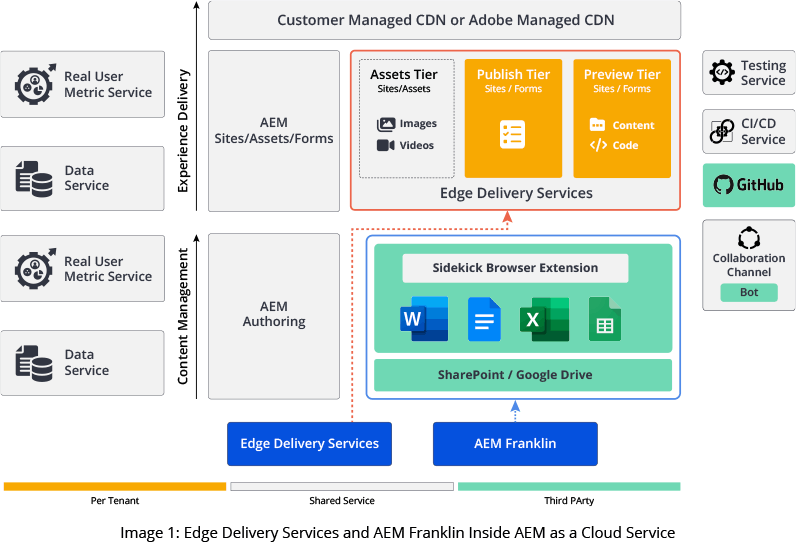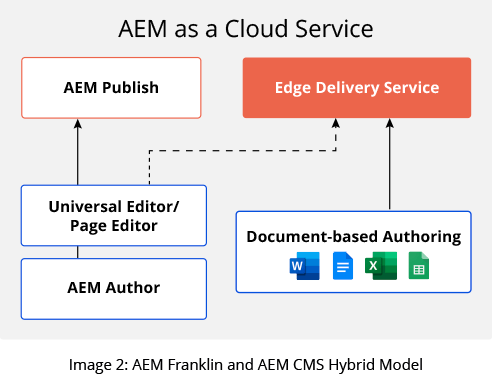In the constantly changing digital world, companies want their websites to be built fast and load faster. At the same time, end users should get a good user experience when they visit the website. Companies are under pressure to provide the latest and most relevant content, smooth user experience, and outstanding performance across all channels. This blog introduces you to Adobe® Experience Manager (AEM) Franklin, a platform that promises to deliver on all the above requirements when coupled with Adobe Edge Delivery Services.
What is Adobe Edge Delivery Services?
Adobe Edge Delivery Services is a serverless technology within AEM designed to enhance site speed, agility, and efficiency by delivering authored content and custom “blocks” with limited developer involvement. It helps generate optimal Google Lighthouse scores, achieved through various optimization techniques such as using vanilla JavaScript, optimizing image delivery, and prioritizing visible content. Additionally, it introduces the concept of “auto blocking” to automatically construct blocks based on recognized relationships between content elements. With an authoring experience primarily within Google Drive or Microsoft SharePoint, Edge Services provides an improved user experience and SEO through its focus on site speed and content delivery optimization.
As you can see from Image 1, Edge Delivery Services fits neatly within Adobe’s AEM as a Cloud Service offering.

What is AEM Franklin?
AEM Franklin introduced a fresh method for publishing AEM pages, using Google Docs or Microsoft Office through SharePoint. Instead of traditional AEM components, it utilizes ‘blocks’ that transform document pieces into web page content, including text, images, buttons, headers, footers, and hero images, enabling rapid page generation and template reuse.
The projects are managed using the Helix Bot and the Sidekick, a Github app that handles content publication. Pages created with Franklin are optimized for fast load times, achieving a Lighthouse score of 99 or 100. However, while AEM Franklin presents initial advantages, it can be matched by AEM standard functionality with proper training and code standards. Customizing blocks requires knowledge of HTML/CSS and JavaScript programming, and it operates outside of the AEM Assets environment, requiring separate access to assets and storage solutions. Despite potential limitations with Google Docs and Microsoft Office/Sharepoint, AEM Franklin will provide full integration with Adobe Cloud in the future.
Why use AEM Franklin?
The benefits of AEM Franklin include excellent performance, no need for standard builds when deploying changes, composable architecture, and low cost.
- Performance: AEM Franklin and Adobe Edge Delivery Services ensure the site performance is consistently 100 or close to 100.
- Build-less Framework: No build is required to make the changes available. Franklin Bot intelligently listens to every code push. Sidekick previews and publishes the content to live websites immediately.
- Composability: Franklin’s composable architecture allows content to be delivered to end users by applying the right decorations. This can be used in ‘headless’ or ‘headed’ implementations. AEM Franklin can also be used along with the AEM CMS for sites using a hybrid model. Image 2 illustrates the model.

Conclusion
Edge Delivery Services, together with AEM Franklin, is a powerful combination that is very promising in terms of reducing the development cycle and faster web publishing. Some key organizations already using this platform are Netcentric, Danaher, Aldevron, Molecular Devices, Mammotome, Adobe WKND, and Volvo Trucks. Companies can use AEM Franklin and Edge Delivery Services to improve user engagement, reduce costs, and provide extreme content velocity, leading to higher conversion rates. However, like other CMS platforms, companies should consider its advantages and disadvantages to determine its project applicability.





